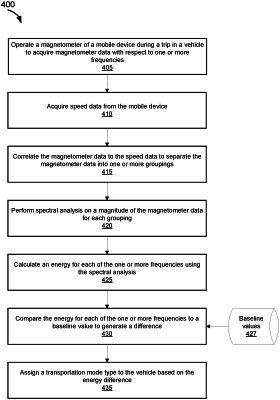| CPC H04W 4/029 (2018.02) [H04M 1/0202 (2013.01); H04M 2250/12 (2013.01); H04W 4/027 (2013.01)] | 20 Claims |

|
1. A method comprising:
obtaining motion data from one or more sensors of a mobile device during a trip;
acquiring speed data from a sensor of the one or more sensors of the mobile device during the trip;
correlating, by a processor, the motion data to the speed data to separate the motion data into one or more groupings based on the speed data;
performing, by the processor, a spectral analysis on magnitudes of the motion data for each of the one or more groupings to obtain a set of frequency components;
calculating, by the processor, an energy for each frequency component of the set of frequency components obtained from the spectral analysis;
comparing, by the processor, the energy of each frequency component of the set of frequency components to one or more baseline values for each frequency component to generate a set of differences; and
determining, by the processor, a transportation mode used for the trip based on one or more differences from the set of differences.
|